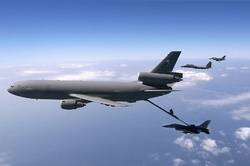Airline Is Last US DC-10 Operator For Passenger Service
 Millions of passengers
have been well-served by three-engine jumbo-jets in the US over the
years. That's about to change as Northwest retires the last of its
fleet of McDonnell Douglas (now Boeing) DC-10 aircraft on
January 8th.
Millions of passengers
have been well-served by three-engine jumbo-jets in the US over the
years. That's about to change as Northwest retires the last of its
fleet of McDonnell Douglas (now Boeing) DC-10 aircraft on
January 8th.
The venerable aircraft have been in service for more than three
decades. Introduced in 1971, the DC-10 competed with Boeing's much
more successful 747, and Lockheed's much less successful
L-1011.
The three jumbo jets made international travel a reality for
many airlines. Their increased range and greater seating capacity
made trans-oceanic travel economically feasible allowing airlines
to add the routes.

The DC-10's typical 250 pax capacity at the time compared to the
747's 370 seats. That made it more attractive to serve smaller
cities unable to justify the larger jet.
Air transport curator at the Smithsonian National Air and Space
Museum Bob van der Linden told USA Today, "The DC-10 introduced
wide-body service to a lot more markets than did the 747."
The DC-10 managed to remain in service despite a number of
high-profile crashes -- six in the 1970s alone. Those six accidents
claimed nearly 1000 lives.
Almost all of the accidents were deemed related to its operation
and maintenance procedures. Only one, a Turkish Airlines flight
departing Paris, was design related. The crew lost control of the
aircraft when its rear cargo door blew out -- the crash killed
345.

Another high-profile crash in 1979 at Chicago had the biggest
negative impact on the aircraft's reputation. A flawed maintenance
procedure resulted in the left-wing engine departing the aircraft
on its takeoff roll. The aircraft was airborne only briefly because
the engine took the wing's control surfaces with it. The aircraft
rolled inverted before crashing and killing 273.
The FAA administrator grounded the entire fleet (despite the
known cause) amid media speculation that passengers would never
again fly on a DC-10.
Of course, those predictions proved false. McDonnell Douglas did
a masterful job of explaining the problem to the public. Add to
that the plane's inherent qualities and passengers were back
aboard with all thoughts of Chicago if not forgotten, at least
ignored.
The plane was also involved in what could be arguably
described as the most famous jetliner crash of all time: United
Flight 232 at Souix City, IA when Captain Al Haynes (pictured
below) managed to crash land a DC-10 with no flight
controls.

When the aircraft's fuselage-mounted engine self-destructed
pieces of shrapnel hit supply lines for all three hydraulic
systems. As the fluid for those systems depleted, all the
aircraft's hydraulically-actuated control surfaces were effectively
locked.
Haynes and his crew including a pilot riding standby kept
the aircraft under tenuous control by varying thrust on the wing
engines -- they were only able to make turns in one direction and
couldn't slow to normal landing speed. Unfortunately, they were
unable to keep the aircraft level on the landing. Of the 296 people
aboard 111 survived; many safety experts credited the plane's
sturdy design with saving them.
DC-10s will continue in service throughout the world in a
variety of rolls. Of the 446 built, 170 are still flying -- most as
freight haulers. Sixty serve as aerial refueling tankers for the US
Air Force.
 ANN's Daily Aero-Linx (04.17.24)
ANN's Daily Aero-Linx (04.17.24) ANN's Daily Aero-Term (04.17.24): Jamming
ANN's Daily Aero-Term (04.17.24): Jamming ANN's Daily Aero-Linx (04.18.24)
ANN's Daily Aero-Linx (04.18.24) Aero-News: Quote of the Day (04.18.24)
Aero-News: Quote of the Day (04.18.24) ANN's Daily Aero-Term (04.18.24): Hold-In-Lieu Of Procedure Turn
ANN's Daily Aero-Term (04.18.24): Hold-In-Lieu Of Procedure Turn






